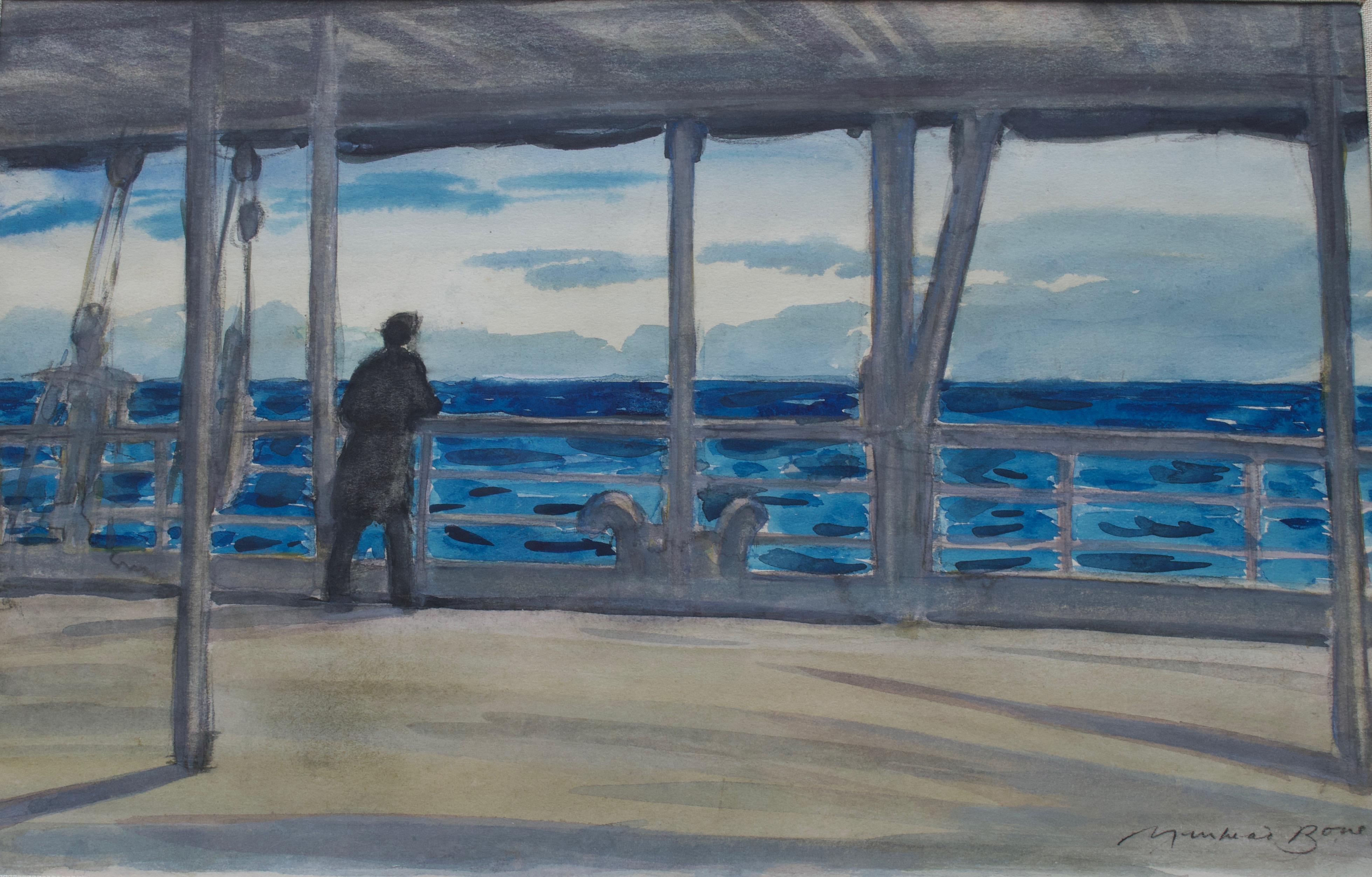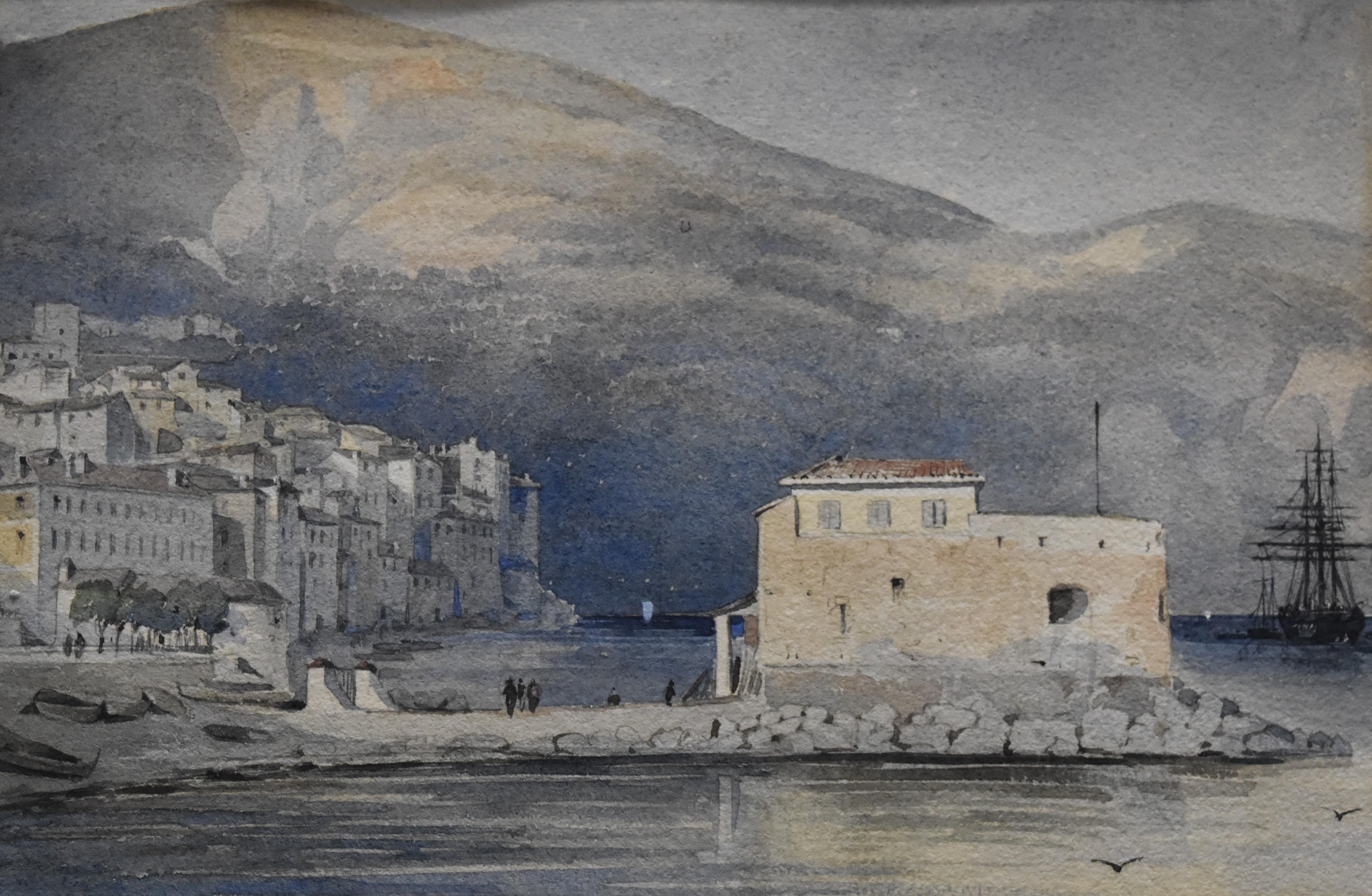Items Similar to Watercolor Interpretation of the The Raft of the Medusa After Théodore Géricault
Want more images or videos?
Request additional images or videos from the seller
1 of 13
Derek CarruthersWatercolor Interpretation of the The Raft of the Medusa After Théodore Géricault1991
1991
About the Item
Watercolour on paper interpretation of the Raft of the Medusa by English artist Derek Carruthers. The work is signed and titled to the back of the paper.
A vivid and engaging interpretation of a famous work by Théodore Géricault. Carruthers has used a distinctive but limited colour palette and loose style to great effect, creating a work that is classic but modern at the same time.
Derek Carruthers was an artist who persisted in asking questions. His interpretation of this painting can be seen in the context of his exploration of his own style and influences. His whole career was inspired by the determination to enquire into the nature of art, examine its purpose, and attempt to explore that place where the individual life of the mind meets the external appearance of the world where personal sensation rubs up against cultural assumptions. Not surprisingly, Carruthers explored, over the years, a language of pure form, abstract space, 2 and 3 dimensions, narrative and concept, personal and universal figuration. Looking back, over decades of work, however, each of these voices is pursuing a coherent set of questions, reflecting on the stuff of human experience. Carruthers’ individual pieces can intrigue and charm, they can be warm and poetic and they can also offer gritty resistance to the easy gaze. They can challenge us to think about ourselves, our environment, our expectations, our place in the world.
The Raft of the Medusa (French: Le Radeau de la Méduse) – originally titled Scène de Naufrage (Shipwreck Scene) – is an oil painting of 1818–19 by the French Romantic painter and lithographer Théodore Géricault (1791–1824). Completed when the artist was 27, the work has become an icon of French Romanticism. At 491 by 716 cm (16 ft 1 in by 23 ft 6 in)] it is an over-life-size painting that depicts a moment from the aftermath of the wreck of the French naval frigate Méduse, which ran aground off the coast of today's Mauritania on 2 July 1816. On 5 July 1816, at least 147 people were set adrift on a hurriedly constructed raft; all but 15 died in the 13 days before their rescue, and those who survived endured starvation and dehydration and practiced cannibalism. The event became an international scandal, in part because its cause was widely attributed to the incompetence of the French captain.
Géricault chose this large-scale uncommissioned work to launch his career, using a subject that had already generated widespread public interest. The event fascinated him, and before he began work on the final painting, he undertook extensive research and produced many preparatory sketches. He interviewed two of the survivors and constructed a detailed scale model of the raft. He visited hospitals and morgues where he could view, first-hand, the colour and texture of the flesh of the dying and dead. As he had anticipated, the painting proved highly controversial at its first appearance in the 1819 Paris Salon, attracting passionate praise and condemnation in equal measure. However, it established his international reputation and today is widely seen as seminal in the early history of the Romantic movement in French painting.
Although The Raft of the Medusa retains elements of the traditions of history painting, in both its choice of subject matter and its dramatic presentation, it represents a break from the calm and order of the prevailing Neoclassical school. Géricault's work attracted wide attention from its first showing and was then exhibited in London. The Louvre acquired it soon after the artist's death at age 32. The painting's influence can be seen in the works of Eugène Delacroix, J. M. W. Turner, Gustave Courbet, and Édouard Manet.
- Creator:Derek Carruthers (1935 - 2021, British)
- Creation Year:1991
- Dimensions:Height: 16.54 in (42 cm)Width: 23.63 in (60 cm)
- Medium:
- Movement & Style:
- Period:
- Condition:Small round imperfection top right original to the hand made rag paper, see photo.
- Gallery Location:Cotignac, FR
- Reference Number:
About the Seller
5.0
Platinum Seller
These expertly vetted sellers are 1stDibs' most experienced sellers and are rated highest by our customers.
Established in 2000
1stDibs seller since 2020
157 sales on 1stDibs
Typical response time: 1 hour
- ShippingRetrieving quote...Ships From: Cotignac, France
- Return PolicyA return for this item may be initiated within 3 days of delivery.
More From This SellerView All
- Fishing Boats, late 19th Century French Marine Mauve Ink DrawingBy Georges Ricard-CordingleyLocated in Cotignac, FRLate 19th century mauve ink drawing on paper of fishing boats at harbour by noted French artist Georges Ricard-Cordingley. The drawing is signed bottom left and carries various annotations and another small sketch. The drawing is presented in a period wood frame under glass with a double card mount. Provenance: This drawing came from the estate of the artist's daughter who had acquired it directly from her father. A charming drawing capturing the scene fishing boats at harbour with extensive detail of the rigging and sails. It seems to be a preparatory sketch as it carries extensive colour and other annotations. There is also a smaller sketch bottom right which shows the boat from a different perspective. The figures are well annotated and Cordingley has achieved great detail but with a lightness of touch. The sketch is even more interesting as it is completed in mauve ink. This was a fashionable and technical innovation at the time as the colour was only 'invented' in the late 1850s. A really interesting, lovely and evocative drawing. Georges Ricard was born on January 30, 1873 in Lyon, son of Prosper Louis Ricard and Georgina Marie Cordingley. He spent part of his childhood in Lyon and Boulogne-sur-Mer. He displayed early gifts for drawing. He lost his father in 1885. He began his training around 1887, becoming a pupil of Jean-Charles Cazin, a landscape painter from Pas-de-Calais and the Côte d'Opale. He then joined the School of Fine Arts in Lyon and remained there from 1888 to 1889. He moved to Paris in 1890, where he studied at the Académie Julian as a pupil of Benjamin Constant, Louis Martinet and Jules Lefebvre. He lost his mother around 1892, went to England to his maternal family and added his mother's name to his name. He embarked for the North Sea with the Royal National Mission to Deep Sea Fishermen and carried out his first studies. In 1894, he met with great success at the court of Queen Victoria. He embarked a second time, in 1895, still for the North Sea and produced numerous studies of waves of clouds, of the port and of portraits of fishermen which he exhibited in Paris and London. He embarked a third time, around 1896, in the North Sea and the Atlantic Ocean with the Société des Travaux de Mer and was shipwrecked in Newfoundland. In 1901, he set up his studio in Boulogne-sur-Mer. He divided his time between London, Paris and Boulogne-sur-Mer and painted portraits and seascapes. He realized the decoration of the casino of Wimereux. He travelled to Australia, where he exhibited from 1909 to 1910. In 1911, he married Suzanne Giraud-Teulon, the daughter of historian Alexis Giraud-Teulon, and had three children, Éliane, Louis and Gabrielle. During the First World War, he was assigned to Lyon as a stretcher...Category
Late 19th Century Romantic Figurative Drawings and Watercolors
MaterialsPaper, Ink
- The Watercarrier, Orientalist Watercolour.Located in Cotignac, FREarly 20th century orientalist watercolour on paper by Aiveill, signed bottom right. In art history, Orientalism is the imitation or depiction ...Category
Early 20th Century Realist Landscape Drawings and Watercolors
MaterialsPaper, Watercolor, Gouache
- 1930s French Watercolour of an Early Art Deco Odeon Cinema and a ParkLocated in Cotignac, FRFrench watercolour on paper view of a park in front of an Odeon cinema by Henri Clamen. Though not signed the painting was acquired from the atelier of the artist with other signed w...Category
Early 20th Century Art Deco Landscape Drawings and Watercolors
MaterialsPaper, Watercolor
- 1930s French Impressionist Watercolour of a Coastal, Marine and Beach SceneLocated in Cotignac, FRFrench Impressionist watercolour on paper view of a beach and marine scene by Henri Clamen. Though not signed the painting was acquired from the atelier o...Category
Early 20th Century Impressionist Landscape Drawings and Watercolors
MaterialsPaper, Watercolor
- The Long Walk Home. Orientalist Watercolour.Located in Cotignac, FREarly 20th century orientalist watercolour on paper by Aiveill, signed bottom right. In art history, Orientalism is the imitation or depiction ...Category
Early 20th Century Realist Landscape Drawings and Watercolors
MaterialsPaper, Watercolor, Gouache
- 19th Century Grand Tour Impressionist View of Santo Stephano, Liguria, Italy.By Hercules Brabazon BrabazonLocated in Cotignac, FR19th century Impressionist view, in pastel, chalk and crayon, in the style of Turner, of Santo Stephano, Imperia, Italy by British artist Hercules Brabazon Brabazon...Category
Mid-19th Century Impressionist Landscape Drawings and Watercolors
MaterialsPaper, Crayon, Pastel
You May Also Like
- Follower of Richard Parkes Bonington, A beached vessel on the coastBy Richard Parkes BoningtonLocated in Harkstead, GBA delicately painted view of figures by a beached fishing vessel on the coast Follower of Richard Parkes Bonington, 19th Century Figures on the shore by a beached vessel Watercolour...Category
19th Century Romantic Landscape Drawings and Watercolors
MaterialsPaper, Watercolor
- Sir David Muirhead Bone, A Mediterranean evening on a P & O cruise linerBy Sir Muirhead BoneLocated in Harkstead, GBA wonderfully evocative scene of a passenger looking out to sea on the deck of an ocean liner - from the golden age of cruising. Sir David Muirhead Bone On a P & O, Mediterranean ev...Category
Mid-20th Century Romantic Figurative Drawings and Watercolors
MaterialsPaper, Watercolor
- English School, circa 1800 Georgian watercolor, The Sailor's returnLocated in Harkstead, GBA delightful rustic scene dating to circa 1800 with the sailor returning to his thankful wife and the domestic idyll of his country cottage. The harbour with sailing ships ferrying c...Category
Early 19th Century Romantic Figurative Drawings and Watercolors
MaterialsWatercolor, Laid Paper
- Historical figurative drawing of 19th century Italian RomanticismLocated in Florence, ITThe subject illustrated here is one of the moments that mark the centuries-long history of Genoa's glorious Maritime Republic, when the ashes of St. John the Baptist, one of the city...Category
1860s Romantic Figurative Drawings and Watercolors
MaterialsPaper, Watercolor, Pen, Pencil
- James Ward The Fisherman's FamilyBy James WardLocated in Saint Amans des cots, FRPrecious Watercolor attributed to James WARD (1769-1859) - England, 1830-1840. The Fisherman' S Family. Measurements : View : 20"x14.6" (51x37 cm), With frame : 26.6"x21.5" (67.5x54....Category
1830s Romantic Figurative Drawings and Watercolors
MaterialsPaper, Watercolor
- 19th Century french school, Villefranche-sur Mer, the harbour, watercolorLocated in Paris, FRFrench School circa 1850 Villefranche sur mer, the Harbour Watercolor on paper 16 x 24 cm In good condition Framed 29 x 38 cm This very fine wat...Category
1850s Romantic Landscape Drawings and Watercolors
MaterialsWatercolor




